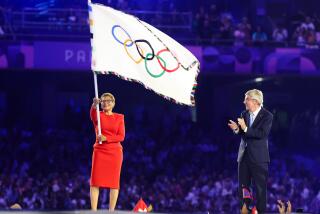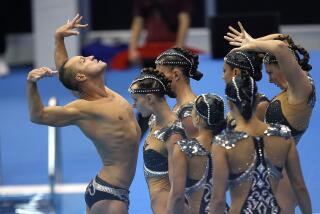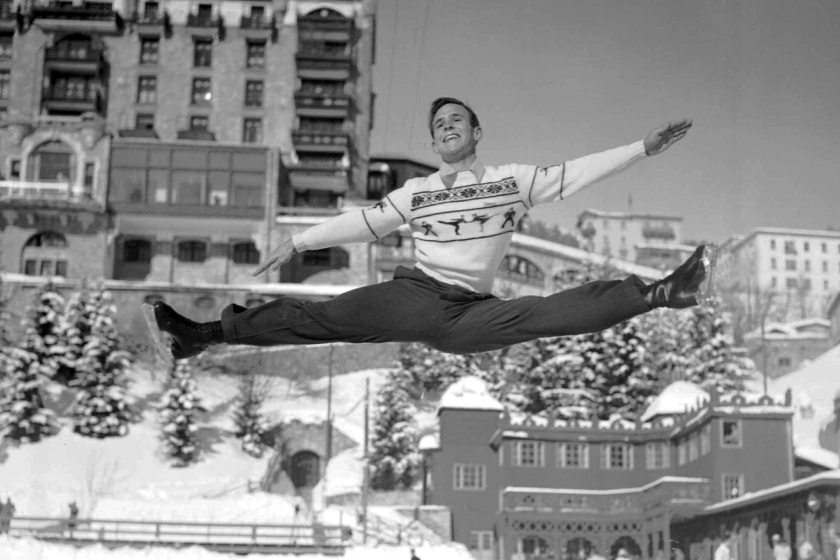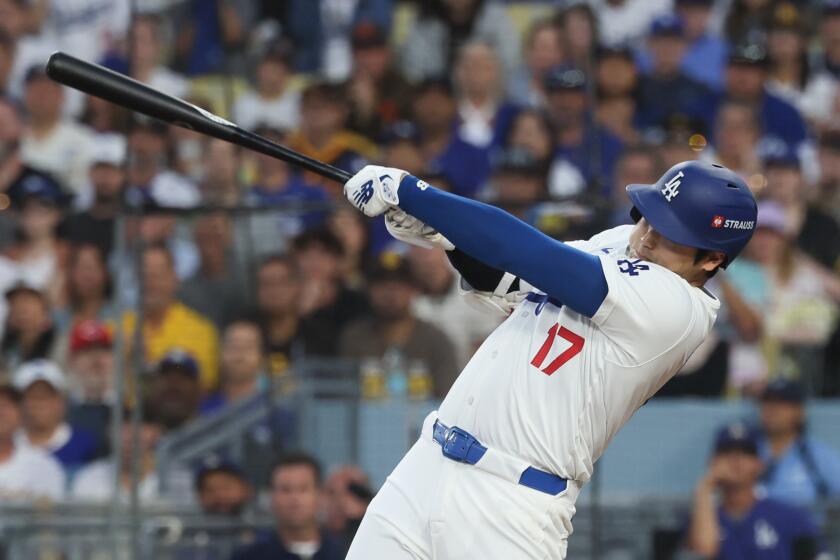Decathlon Feat in 1948 Was a 10 for Mathias
- Share via
Forty years ago today, a young man from a Central California farm town walked into a leftover World War II barracks 10 miles outside of London.
It was after midnight. It was dark and quiet inside, and he was careful to close the door softly. He could hear his fellow American athletes snoring softly in their narrow beds.
He undressed quietly and slipped into bed.
He blinked a few times, stared at the ceiling, and tried to comprehend what he’d just done.
But he couldn’t. He was too exhausted.
Quickly, he was asleep.
His name was Bob Mathias.
He had just won the decathlon in the Olympic Games.
He was 17 years old.
MEMORIES
Bob Mathias, 57, sat behind a desk at the Irvine Marriott Hotel, where today he runs an organization called the American Kids Sports Assn.
The question was: What is the most vivid memory of your 1948 Olympic experience?
“It’s two things, actually,” he said.
“The first is the shock of seeing all the World War II bombing damage in London. I was just a kid from Tulare, who’d only heard about the war on the radio and read about it.
“There were still piles of rubble all over the place, and bomb craters.
“The second thing is the last event, the 1,500 (meters). By then, I knew that any decent time at all would win it for me. And yet the race itself was like a dream. It was raining softly then, it was very late at night, maybe 11 o’clock, and very quiet.
“My mom and dad were in the stands. I remember Paul Zimmerman (then sports editor of The Times) there, and there might not have been 100 other people still in the stadium, which had 80,000 seats.
“Wembley was a poorly lighted place. They had dog racing there, and we were running only by the dog racing lights--8-foot light poles about 50 feet apart, right on the infield side of the track.
“So I was running alone, from misty darkness, into misty pools of light, and back into misty darkness again. The whole situation had become unbelievable to me--I didn’t think I had a chance in the world of winning when I got to London--but that 1,500 made it seem really strange.”
TULARE
Taking the exit off California 99 in the vast San Joaquin Valley, you go only two blocks west, past old, lush cottonwood trees, before you see you have taken the right turnoff. “Bob Mathias Stadium,” the sign behind the bleachers reads. Old, two-story high school. Old trees. Tulare High looks pretty much the way Mathias left it, 40 years ago.
Downtown, though, even Mathias has trouble figuring out where he is. There are new bank buildings, supermarkets, video stores, fast-food joints everywhere, and entire shopping centers.
Mathias remembers the drug store with the soda fountain, and the old one-pump gas station where he pumped up his bike tires. All gone.
When Mathias went to the Olympics in 1948, Tulare’s population was 13,000. Now it’s 30,000.
The old family home on E. King Street remains, the one Dr. Charles Mathias built in 1934. It still has a tidy lawn and is shaded by high, leafy trees. Mathias’ mother, 81, still lives there. His dad, a Tulare family doctor for 44 years, died in 1985.
Bob Mathias’ older brother, Eugene, is a general practitioner in Tulare today.
Bob Mathias’ room, the one he shared with his younger brother, Jimmy, is behind the house, above the garage. There, Mathias and his boyhood pals, Sim Iness, Dave Sturgeon and Bob Abercrombie, used to lie around on the floor and listen to “Boston Blackie” and, ironically, as it would turn out, “Jack Armstrong, All-American Boy,” on the radio.
After the 1948 Olympics, Bob Mathias left Tulare for an eastern prep school to beef up his grades for Stanford. When he returns, it’s to visit his mother.
But his two gold medals--he also won the 1952 decathlon gold medal--remain. They’re in the Bob Mathias room at the Tulare Public Library, along with all his other sports awards, from high school through Stanford, and the 1952 Olympics.
In a bit of an experiment, a young man busing dishes behind the coffee shop counter is asked, “Have you lived in Tulare all your life?”
“Yeah.”
“Have you ever heard of Bob Mathias?”
“Yeah. He was a football player here. They named the stadium after him.”
THE NATURAL
When magazine writers were flocking to Tulare in late 1948, old Doc Mathias claimed to have seen it coming from babyhood.
And Doc Mathias, an all-conference football player at Oklahoma in the 1920s, knew a thing or two about babies. He’d delivered 4,000 of them.
“Physically, Bob was exceptional even as a toddler,” he said. “We noticed he never fell off chairs, never ran into things, or stumbled and fell down much. He really was a natural athlete.”
According to an old clipping in the Bob Mathias room, Mathias participated in his first track meet at age 12 and leaped 5 feet 6 inches in the high jump. But in high school, and before 1948, Mathias was known as a football star, even though he participated in every sport.
As a running back for the Tulare Redskins in 1947, he averaged 9 yards a carry.
And the next spring, track season started.
And what a track season Bob Mathias had in 1948.
Most high school track stars these days finish their season at the state meet. In 1948, Bob Mathias finished his on the victory stand at the Olympics.
The following is from the files of Ripley’s “Believe It or Not:”
--On Nov. 17, 1947, Tulare High track coach Virgil Jackson suggested to Mathias, a hurdles-sprint star the previous spring, that he begin thinking about working on some other track events; like the discus, high jump, pole vault and shotput. . . . And 232 days later, he won the Olympic decathlon.
--Two months before the 1948 Olympic Games, Bob Mathias had not only never competed in a decathlon, he had never competed in 6 of the 10 events.
--Four months before the 1948 Olympic Games, Bob Mathias had never tried the pole vault.
--Four months before the 1948 Olympic Games, Bob Mathias had never seen a javelin.
In fact, as far as anyone knew, there was not a javelin anywhere in Tulare County.
“I’ve always heard two versions of where my first javelin came from,” Mathias said recently.
“One is that Virgil Jackson got one from a guy in Porterville who’d had one in his attic for 20 years. The other story is that he got it from Fresno State. To this day, I really don’t know where he got it.”
In the 1948 state high school track meet at Berkeley, Mathias won two events, the 120-yard high hurdles in 14.5 seconds and the 180 lows in 19.6.
Then he decided to give up his summer job--loading 100-pound sulfur sacks into crop-dusting planes at the Visalia airport--and take up the decathlon.
His competed in his first decathlon at the Pasadena Games, held at the Coliseum, in June of 1948. The meet was a qualifier for the Olympic team trials at Bloomfield, N.J., later that month. Mathias, competing in six of the events for the first time, won, scoring 7,094 points, the best mark in the world since 1940.
Tulare went nuts. Mathias had qualified for the Olympic trials. How about that!
Two weeks later in New Jersey, Mathias won the trials decathlon with 7,224 points. He was going to the Olympic games.
Jim Scott, a sportswriter for the Berkeley Gazette, wrote: “It could be that Bob Mathias is the greatest all-around athlete ever produced in California.”
Tulare went nuts again. Hundreds of people met him at the Visalia airport when he returned. There was a mini-parade, led by a brass band.
THE SUMMER OF ’48
“On the boat going over, I didn’t even think about winning the event,” Mathias said recently.
“Remember, there’d been a war--there hadn’t been an Olympic decathlon since 1936. The coaches had no idea who was good around the world. And I still couldn’t believe I’d beaten Moon Mondschein and Floyd Simmons at the trials.
“Mondschein was a real man. He’d been through the war in the Pacific. I was just a star-struck kid.
“At the end of the first day, I was third or fourth. I hadn’t fouled up anywhere. But I still didn’t have an inkling I would win. After the first day, I was just happy knowing I wasn’t going to come in last.”
On Day 2, Mathias’ attitude changed after the second event, the discus. He got off by far the longest throw of the competition. And therein lies another story.
“The judges were marking the throws with little wooden pegs, and the thrower after me knocked my peg out of the ground on the first bounce of his throw,” Mathias said.
“It was getting dark and it took them over a half-hour to decide where to put my peg. They credited me with 144 feet 4 inches, but a lot of people said it was longer than that.
“Anyhow, by then I was in first place. I had a little decathlon scoring chart in my bag and I kept adding up my scores over and over. I couldn’t believe it. I thought maybe there’d been a mistake.
“There was a long delay getting the scores on the scoreboard, but there I was, on top.
“The pole vault, my weakest event, was next but I cleared 11-6, to stay even.
“The Argentine, Enrique Kistenmacher, was a big, tall guy and I figured he’d throw the javelin way out there.
“But he actually threw poorly and I didn’t foul up, so going into the 1,500, I knew I’d win if I didn’t fall down.
Mathias ran a slow 5 minutes 11 seconds and won the gold medal. “My mom and dad came onto the track, my mom hugged me, and we walked toward the dressing room together,” he said.
“I talked to Paul Zimmerman a while, then caught the athletes’ bus back to the village. I didn’t talk to a soul at the village because everyone was asleep.”
THE SPORTS EDITOR
Paul Zimmerman is 85 now. He was sports editor of The Times from 1939 to 1968.
“I still consider Mathias in London the most exciting story I ever covered, certainly the biggest sports story I ever wrote,” he said.
“The things I remember most were the terrible weather--it rained both days--and the terrible lights. And yet, here was this kid from California, who’d never even been in a decathlon until the previous June, right up with the leaders.
“I remember the discus foul-up well. The judges cost him about a hundred points when they lost his mark.
“I remember he had trouble at the opening height in the pole vault, primarily because it was a new event to him and he was so tired. He was having trouble with the opening height, 8 1/2 or 9 feet.
“Finally, the judges let him put a handkerchief on the bar so he could see it, and two white tennis shoes at the pole box, so he could see that.
“He cleared 11 feet, which was decent. He didn’t get hurt, points-wise. In those days reporters could go down on the field during the competition. I went up to Bob and told him that with a decent javelin and any kind of 1,500 time, he’d win.
“They were using torch lights to mark the approach area to the javelin. He had the longest throw of his life, and at that point I knew he had it.”
THE AFTERMATH
On the way home to Tulare, Mathias stopped in Washington, where he met President Truman.
And when he finally got home, the little city went nuts again.
This time, police had to clear Tulare citizens off the Visalia airport runway so that Mathias’ plane, circling overhead, could land. While the band played and politicians made speeches--Visalia’s mayor was Elmo Zumwalt, whose son, Elmo, Jr., eventually became Chief of Naval Operations--carbide bombs were detonated at the other end of the airport.
It was a day of sirens, fire whistles, car horns, firecrackers, welcome-home signs, more carbide bombs, cheering and tears. A little town had a hero. At home that night, Mathias had bruises from all the backslaps.
Mathias’ stay on the sports scene, however, was surprisingly brief, which he regrets today. He attended Kiski Prep in Pennsylvania before transferring to Stanford, where he played football for three seasons. He dropped out of football before his senior year to train for the 1952 Olympics.
He was a phenom in football, a big back who could fly. He is best remembered for the 1951 USC game in the Coliseum, when he returned a kickoff 96 yards in a 27-20 Stanford victory.
“The only SC guy who touched me on that return was Frank Gifford,” Mathias said. “He didn’t bring me down, and of course I never fail to remind him whenever I see him.”
He was drafted by the Washington Redskins, who wanted to make him a wide receiver. Instead, he made a movie, “The Bob Mathias Story,” and never did play in the National Football League.
“Yes, I’d say I regret today never playing pro football,” he said. “But then, I also regret not competing in the 1956 Olympics, too.”
“The AAU (Amateur Athletic Union) declared me a pro after I made that movie, and endorsed a couple of products. I decided in 1955 I wanted to go for a third decathlon championship, and wrote a letter to Dan Ferris who at the time was running the AAU.
“He wrote me a letter, listing 10 things I had to do, one of which was return all the money I’d made from that movie. Well, that money had been spent. I sat down and talked to him about it, and he was adamant. He wouldn’t reinstate me.
“At the time, I was terribly disappointed. In 1956, I was still only 25. I was at my peak, still growing as an athlete.”
Mathias was a U.S. Congressman from 1967 to 1975, which was shortly after he had voted against a federal education bill.
“I enjoyed representing people in Congress very much, but the frustrating part was that you can vote the way people want you to 99 times out of 100 and if they don’t like that 100th vote, that’s the one they never forget.
“(President) Nixon sent up a federal-aid-to-education bill that was 15% over what was spent the previous year. I’m a Republican, and a fiscal conservative. With great reluctance, I decided to vote for the bill.
“But I would not vote for an amendment to the bill that would have raised the spending even higher. The National Education Assn. didn’t like that and I got a letter from every schoolteacher in my district, calling me anti-education.”
After losing his Congressional seat in the 1974 election, Mathias served briefly as deputy director of the selective service, then as California finance director of the 1976 Ford-for-President campaign.
He ran the U.S. Olympic Training Center in Colorado Springs for seven years, then left to work for former NFL coach George Allen. Allen was putting together plans for a National Fitness Foundation facility. Eventually, as Mathias puts it, he encountered “philosophical differences” with Allen and left the project.”
THE CHAMPION, AT 57
It’s almost unfair what’s happened to Bob Mathias.
First of all, there is still plenty of hair and it isn’t gray. It went from black to sandy, almost blond. There are very few lines in the face. There is no paunch. He is still slim and trim and walks with the floating grace of an athlete.
Near the end of an interview, he recalled one more moment from his summer of ’48.
“The first person who said anything to me in the Olympic Village the morning after I won was Mel Patton,” he said.
Patton, the USC sprinter known as “the world’s fastest human” going into the Olympics, approached Mathias and shook his hand.
“Here was a guy I looked up to. I hadn’t said a word to him up to then, not even on the boat ride over. I was in awe of the guy.
“So he walks up to me, shakes my hand, and says: ‘Nice goin’, kid.’ ”
THE BEST OF THE BEST Marks of the top decathletes of all time:
JIM THORPE, UNITED STATES, 1912 STOCKHOLM OLYMPICS
100M LJ Shot HJ 400M 110H Disc PV Jav 11.2 22-3 1/2 42-3 1/2 6-1 1/2 52.2 15.6 121-4 10-8 149-11
100M 1500M Points 11.2 4:40.1 8,412
BOB MATHIAS, UNITED STATES, 1948 LONDON OLYMPICS
100M LJ Shot HJ 400M 110H Disc PV Jav 1500M 11.2 21-8 42-9 1/2 6-1 51.7 15.7 144-4 11-5 3/4 165-1 5:11.1
100M Points 11.2 7,139
DALEY THOMPSON, GREAT BRITAIN, 1984 LOS ANGELES OLYMPICS
100M LJ Shot HJ 400M 110H Disc PV Jav 1500M 10.44 26-3 1/2 51-7 6-8 46.97 14.33 152-9 16-4 3/4 214-0 4:35.0
100M Points 10.44 8,798
More to Read
Go beyond the scoreboard
Get the latest on L.A.'s teams in the daily Sports Report newsletter.
You may occasionally receive promotional content from the Los Angeles Times.






